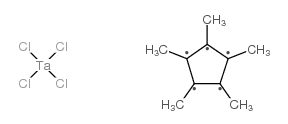71414-47-6
| Name | Pentamethylcyclopentadienyltantalum tetrachloride |
|---|---|
| Synonyms |
MFCD00070463
carbanide,cyclopenta-1,3-diene,tantalum,tetrachloride |
| Melting Point | >300ºC |
|---|---|
| Molecular Formula | C10H15Cl4Ta |
| Molecular Weight | 457.98600 |
| Exact Mass | 455.94100 |
| LogP | 5.73000 |
|
Section 1: Product Identification Chemical Name:Pentamethylcyclopentadienyltantalum tetrachloride, 98% CAS Registry Number:71414-47-6 Formula:[C5(CH3)5]TaCl4 EINECS Number:none Chemical Family:metallocene Synonym:Tantalum tetrachloride, pentamethylcyclopentadienyl complex
Section 2: Composition and Information on Ingredients IngredientCAS NumberPercentACGIH (TWA)OSHA (PEL) Title compound71414-47-6100%no datano data Section 3: Hazards Identification Corrosive to skin and eyes. Material hydrolyzes in contact with moisture releasing toxic and corrosive fumes Emergency Overview: of hydrogen chloride and aqueous hydrochloric acid. Primary Routes of Exposure:Contact with skin and eyes. Inhalation of dust. Eye Contact:Corrosive to the eyes. Skin Contact:Causes chemical burns to the skin. Inhalation:Forms hydrogen chloride in the presence of moisture. Inhalation will lead to burning of the respiratory tract. Ingestion:If large amounts ingested, severe burns to the gastrointestinal tract may occur. Corrosive to skin, eyes and respiratory tract. Causes eye and skin burns, dyspnea (difficulty breathing) and Acute Health Affects: pulmonary edema. Chronic Health Affects:No information available on long-term chronic effects. NTP:No IARC:No OSHA:No SECTION 4: First Aid Measures Immediately flush the eyes with copious amounts of water for at least 10-15 minutes. A victim may need Eye Exposure: assistance in keeping their eye lids open. Get immediate medical attention. Wash the affected area with water. Remove contaminated clothes if necessary. Seek medical assistance if Skin Exposure: irritation persists. Remove the victim to fresh air. Closely monitor the victim for signs of respiratory problems, such as difficulty in Inhalation: breathing, coughing, wheezing or pain. In such cases seek immediate medical assistance. Seek medical attention immediately. Keep the victim calm. Give the victim water (only if conscious). Induce Ingestion: vomiting only if directed by medical personnel. SECTION 5: Fire Fighting Measures Flash Point:no data Autoignition Temperature:no data Explosion Limits:no data Extinguishing Medium:carbon dioxide, dry powder or foam. If involved in a fire, fire fighters should be equipped with NIOSH approved positive pressure self-contained Special Fire Fighting Procedures: breathing apparatus and full protective clothing. Hazardous Combustion andIf involved in a fire this material may release corrosive hydrogen chloride fumes. Decomposion Products: Unusual Fire or Explosion Hazards: No unusual fire or explosion hazards. SECTION 6: Accidental Release Measures Spill and Leak Procedures:Small spills can be mixed with powdered sodium bicarbonate, lime, or calcium carbonate and swept up. SECTION 7: Handling and Storage Handling and Storage:Handle and store the material under an inert atmosphere of nitrogen or argon. SECTION 8: Exposure Controls and Personal Protection Eye Protection:Always wear approved safety glasses when handling a chemical substance in the laboratory. Skin Protection:Wear protective clothing and gloves. Consult with glove manufacturer to determine the proper type of glove. Ventilation:Material may emit corrosive fumes. Handle the material in an efficient fume hood. If ventilation is not available a respirator should be worn. The use of respirators requires a Respiratory Respirator: Protection Program to be in compliance with 29 CFR 1910.134. Ventilation:Material may emit corrosive fumes. Handle the material in an efficient fume hood. Additional Protection:No additional protection required. SECTION 9: Physical and Chemical Properties Color and Form:orange powder Molecular Weight:458 Melting Point:220° Boiling Point:no data Vapor Pressure:no data Specific Gravity:no data Odor:pungent odor Solubility in Water:reacts with water SECTION 10: Stability and Reactivity Stability:air and moisture sensitive Hazardous Polymerization:No hazardous polymerization. Conditions to Avoid:none Incompatibility:water and halogens Decomposition Products:carbon monoxide, carbon dioxide, tantalum oxide, chlorinated organics, organic fumes. SECTION 11: Toxicological Information RTECS Data:No information available in the RTECS files. Carcinogenic Effects:no data Mutagenic Effects:no data Tetratogenic Effects:no data SECTION 12: Ecological Information Ecological Information:No information available SECTION 13: Disposal Considerations Disposal:Dispose of according to local, state and federal regulations. SECTION 14: Transportation Shipping Name (CFR):Corrosive solids, N.O.S. Hazard Class (CFR):8 Additional Hazard Class (CFR):NA Packaging Group (CFR):II UN ID Number (CFR):UN# 1759 Shipping Name (IATA):Corrosive solid, N.O.S. Hazard Class (IATA):8 Additional Hazard Class (IATA):NA Packaging Group (IATA):II UN ID Number (IATA):UN# 1759 SECTION 15: Regulatory Information TSCA:Not listed in the TSCA inventory SARA (Title 313):Title compound not listed. Second Ingredient:none SECTION 16 - ADDITIONAL INFORMATION N/A |
| Hazard Codes | C:Corrosive; |
|---|---|
| Risk Phrases | R14;R34 |
| Safety Phrases | S26-S36/37/39-S45 |
| RIDADR | UN 3261 |
| Packaging Group | II |


